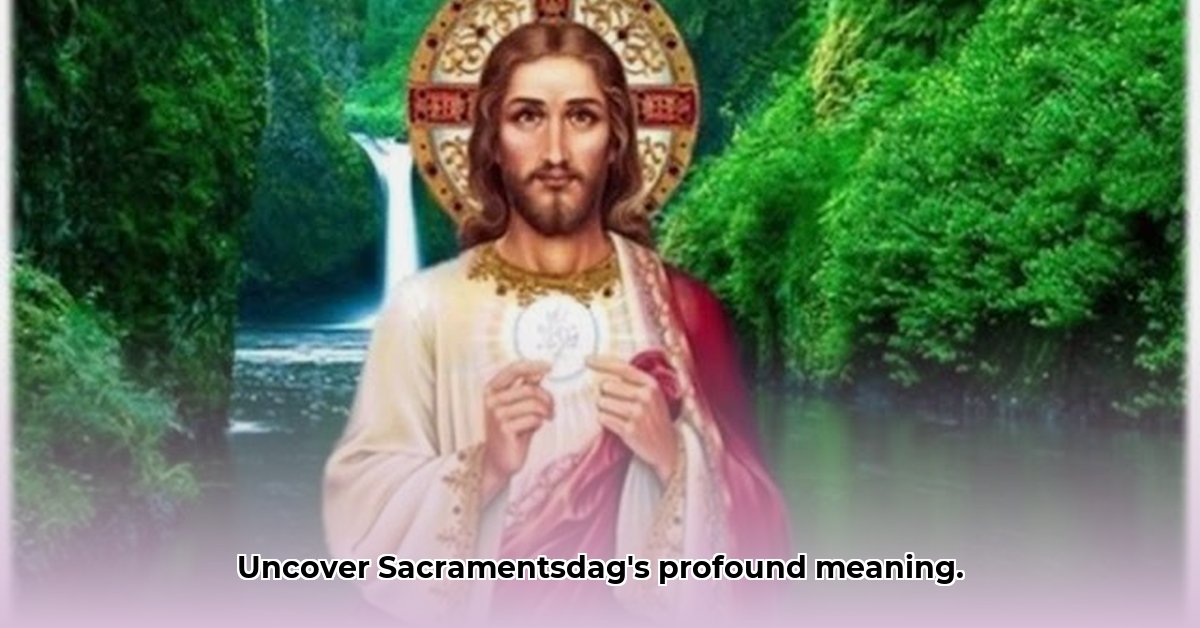
Imagine a vibrant street parade, not of cars and floats, but of faith and devotion – a moving tapestry of song, prayer, and the fervent belief in the Real Presence of Christ. This is the essence of Sacramentsdag (Corpus Christi), a feast day rich in history and profound in its meaning. More than just a date on the church calendar, Sacramentsdag offers a compelling journey through time, showcasing the evolution of religious practice and the enduring power of faith in South Africa and beyond.
Sacramentsdag Betekenis: A Journey Through Time and Faith
The story of Sacramentsdag begins in the 13th century with Juliana of Cornillon, a woman whose profound faith led to powerful visions centred on the Eucharist – the consecrated bread and wine believed by Catholics to be the actual body and blood of Christ. These visions, deeply moving and intensely personal, became the catalyst for a new feast day dedicated to celebrating this central act of Catholic worship. How did such a personal experience shape the liturgical calendar of the entire Catholic Church?
This wasn't a simple process. Initially, the celebration of Corpus Christi was localised. However, things shifted dramatically in 1264 when Pope Urban IV declared it a universal feast day for the whole Catholic Church. Legend speaks of the "Miracle of Bolsena," where during a Mass, a consecrated host mysteriously began to bleed. This miraculous event, widely believed at the time, significantly influenced the Pope's decision, giving immediate weight and widespread acceptance to the new feast. The power of belief, seemingly substantiated by a miracle, profoundly accelerated the adoption of this now globally celebrated day.
Adding intellectual heft to the new feast was the renowned theologian, Thomas Aquinas. His profound theological insights provided a robust framework supporting the feast's significance, making its underlying principles accessible to both scholars and the everyday faithful. Aquinas' work ensured Sacramentsdag held a firm place within the broader theological landscape.
Over the centuries, celebrations continued to flourish. The beautiful hymn, "Lauda Sion," became intrinsically linked to the Mass, while grand processions, resplendent displays of communal faith, became a striking feature of the day. Even these processions haven't had a smooth journey. Public religious displays were banned in some areas, such as parts of the Netherlands, creating tension between faith and government. This conflict highlights the sometimes complex relationship between religious practice and political control.
At its heart, Sacramentsdag Betekenis centres on the Real Presence of Christ in the Eucharist – a core belief in Catholicism, but also a point of intense historical and theological debate. The Reformation, for example, witnessed a fracturing of perspectives on the Eucharist, clearly illustrating its continued influence on shaping and reshaping Christian thought.
The Enduring Legacy of Sacramentsdag: Faith, Adaptation, and Ongoing Dialogue
Today, Sacramentsdag remains a vibrant celebration worldwide, adapted and expressed through diverse cultural lenses. From solemn masses to joyful processions, the feast day reflects the rich tapestry of Catholic communities in South Africa and beyond. Although deeply rooted in Catholic faith, its significance extends beyond denominational boundaries, sparking ongoing discussions within the broader Christian context about the true meaning and interpretation of the Eucharist.
This isn't merely a historical account but a testament to the ongoing evolution of faith. Sacramentsdag's journey from a personal vision to a global celebration showcases the dynamic nature of religious belief and practice – an evolution that continues to shape religious landscapes in South Africa and across the world. The continued relevance of Sacramentsdag powerfully highlights the enduring impact of the Eucharist on those who believe.
Key Insights:
- Visionary Beginnings: Juliana of Cornillon's mystical visions formed the foundation of Sacramentsdag, highlighting the role of individual faith in shaping religious tradition.
- Papal Authority: Pope Urban IV's declaration of Sacramentsdag as a universal feast demonstrates the influence of papal authority in shaping the Catholic liturgical calendar.
- Theological Depth: Thomas Aquinas's theological contributions provided a firm intellectual basis for the feast, making its meaning accessible to a broader audience.
- Ongoing Dialogue: The Real Presence of Christ in the Eucharist, the very heart of Sacramentsdag, remains a topic of ongoing conversation and debate within Christianity, demonstrating its sustained theological relevance.
Sacramentsdag Betekenis is far more than a single day on the calendar. It is a living testament to faith, a journey through history, and a continuing dialogue on the enduring significance of the Eucharist. Its story remains vibrant, an enduring legacy of belief and its transformative power.